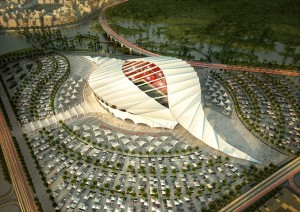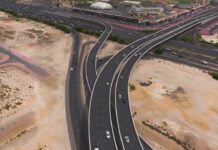By Bonnie James www.gulf-times.com
The total projected investment in rail projects in the GCC countries over the next 15 years is in excess of $100bn, including Qatar’s $35bn, the World Cup Construction Conference was told yesterday.

“These include passenger and freight rail networks, metro, Light Rail Transit (LRT) and tram,” Hyder Consulting’s regional rail director (Mena) Geoff Leffek said at the event hosted by Construction Week magazine.
Qatar’s railway plans include the Doha Metro with 98 stations and 355km of track in four lines, rail networks to Bahrain and Saudi Arabia, the Lusail light rail and the Education City people mover system.
“The Doha Metro, the majority of which would be ready for the 2022 Football World Cup, is to comprise 170km track at grade level, 70km of elevated track, and 115km of tunnels,” he said.
The GCC railway project, linking the six Gulf nations and spanning 2,200km will attract an investment of $30bn.
Saudi Arabia is looking at 23 major transportation projects valued at $26bn, including a Makkah-to-Madina high-speed rail, and freight, passenger, metro and monorail networks.
Kuwait has plans for a metro in addition to the GCC railway network. Oman is eyeing only the GCC railway project. Bahrain’s $8bn schemes include the LRT, monorail, tram and bus rapid transit.
Abu Dhabi is poised to be the biggest regional spender in public transport with a proposed investment of $68bn covering metro, tram and a regional rail network with the emirate.
The UAE is also planning for a union railway network at an investment of $11bn.
“The challenges for railway projects in the region are windblown sand and that ground conditions are not ideal, but all efforts are being undertaken to overcome these and the end result would be excellent,” Leffek said.
He highlighted, during a panel discussion moderated by Pinsent Masons (UAE) managing partner Sachin Kerur, the need for regulatory frameworks before work is started on rail projects, and feared that “this will be left very late.”
Leffek said the availability of physical and human resources would pose a big challenge for the railway projects in the region and “there may not be enough specialists to go around.”
His comments followed Parsons Corporation vice president (rail and transit systems) Jerry Harrison who said that huge rail projects are going on in China and India.
“Integration is key to the success of public transport,” he said, while Booz & Company partner Dr Ulrich Koegler cited the need to build transport hubs around railway stations.
One of the reasons for the increasing popularity of the Dubai Metro is that it is easy to get to and get away, Leffek said.
Aedas transport sector leader (Middle East) Simon Summers was in favour of levying congestion charges and road tolls from motorists in order to encourage the use of the rail network once in place.
However, Leffek said there are people who will never get out of their cars to take public transport.
He cited the example of some Londoners who continue to drive to Central London paying the congestion charge though the city has a well established underground railway network in addition to buses and trams.



















